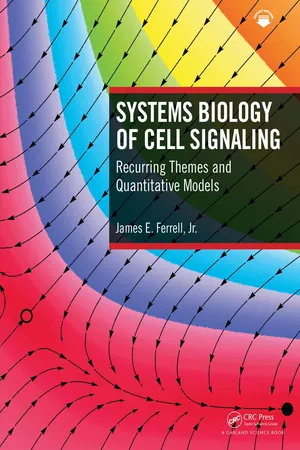
- 264 pages
- English
- ePUB (mobile friendly)
- Available on iOS & Android
About this book
How can we understand the complexity of genes, RNAs, and proteins and the associated regulatory networks? One approach is to look for recurring types of dynamical behavior. Mathematical models prove to be useful, especially models coming from theories of biochemical reactions such as ordinary differential equation models. Clever, careful experiments test these models and their basis in specific theories. This textbook aims to provide advanced students with the tools and insights needed to carry out studies of signal transduction drawing on modeling, theory, and experimentation. Early chapters summarize the basic building blocks of signaling systems: binding/dissociation, synthesis/destruction, and activation/inactivation. Subsequent chapters introduce various basic circuit devices: amplifiers, stabilizers, pulse generators, switches, stochastic spike generators, and oscillators. All chapters consistently use approaches and concepts from chemical kinetics and nonlinear dynamics, including rate-balance analysis, phase plane analysis, nullclines, linear stability analysis, stable nodes, saddles, unstable nodes, stable and unstable spirals, and bifurcations. This textbook seeks to provide quantitatively inclined biologists and biologically inclined physicists with the tools and insights needed to apply modeling and theory to interesting biological processes.
Key Features:
- Full-color illustration program with diagrams to help illuminate the concepts
- Enables the reader to apply modeling and theory to the biological processes
- Further Reading for each chapter
- High-quality figures available for instructors to download
Frequently asked questions
- Essential is ideal for learners and professionals who enjoy exploring a wide range of subjects. Access the Essential Library with 800,000+ trusted titles and best-sellers across business, personal growth, and the humanities. Includes unlimited reading time and Standard Read Aloud voice.
- Complete: Perfect for advanced learners and researchers needing full, unrestricted access. Unlock 1.4M+ books across hundreds of subjects, including academic and specialized titles. The Complete Plan also includes advanced features like Premium Read Aloud and Research Assistant.
Please note we cannot support devices running on iOS 13 and Android 7 or earlier. Learn more about using the app.
Information
1
INTRODUCTION
IN THIS CHAPTER . . .
- 1.1 SIGNAL TRANSDUCERS ARE CELLULAR COMPONENTS THAT ACT MAINLY BY REGULATING OTHER CELLULAR COMPONENTS
- 1.2 THE SIGNAL TRANSDUCTION PARTS LIST IS LONG
- 1.3 SIGNAL TRANSDUCTION IN BACTERIA IS ACCOMPLISHED BY SHORT, (MOSTLY) LINEAR, (MOSTLY) NON-INTERCONNECTED PATHWAYS
- 1.4 THE EGFR SYSTEM IS DEEP, INTERCONNECTED, AND COMPLICATED
- 1.5 COMPLICATED SYSTEMS CAN BE SIMPLIFIED BY ASSUMING MODULARITY
- 1.6 ORDINARY DIFFERENTIAL EQUATIONS PROVIDE A POWERFUL FRAMEWORK FOR UNDERSTANDING MANY SIGNALING PROCESSES
- 1.7 THEORY CAN HELP HIGHLIGHT THE COMMONALITIES OF DIVERSE BIOLOGICAL PHENOMENA
- 1.8 SIX BASIC TYPES OF RESPONSE ARE SEEN OVER AND OVER AGAIN IN CELL SIGNALING
- 1.9 FIVE OR SIX BASIC CIRCUIT MOTIFS ARE SEEN OVER AND OVER AGAIN IN SIGNALING SYSTEMS
- SUMMARY
- MOVING FORWARD
- FURTHER READING

| U.S. Prescriptions (millions) | ||||||||
|---|---|---|---|---|---|---|---|---|
| Drug | Indications | Mechanism of Action | 2014 | 2015 | 2016 | 2017 | 2018 | |
| 1 | Atorvastatin | High cholesterol | Inhibits cholesterol synthesis | 74 | 94 | 97 | 105 | 112 |
| 2 | Levothyroxine | Hypothyroidism | Activates thyroid hormone receptors | 100 | 113 | 114 | 102 | 105 |
| 3 | Lisinopril | Hypertension | Inhibits the last step in the production of the hormone angiotensin II | 114 | 110 | 109 | 104 | 97 |
| 4 | Metformin | Type II diabetes mellitus | Inhibits mitochondrial respiratory-chain complex 1 | 85 | 83 | 80 | 78 | 84 |
| 5 | Amlodipine | Hypertension, angina pectoris | Inhibits voltage-gated calcium channels | 63 | 71 | 75 | 73 | 76 |
| 6 | Metoprolol | Hypertension, angina pectoris, and myocardial infarction | Inhibits β1-adrenergic receptors | 71 | 69 | 73 | 67 | 71 |
| 7 | Albuterol | Asthma and chronic obstructive pulmonary disease | Activates β2-adrenergic receptors | 48 | 50 | 47 | 50 | 61 |
| 8 | Omeprazole | Gastroesophageal reflux disease and gastric ulcers | Inhibits H+/K+ ATPase | 71 | 71 | 70 | 58 | 58 |
| 9 | Losartan | Hypertension | Inhibits angiotensin II receptors | 37 | 47 | 49 | 52 | 51 |
| 10 | Simvastatin | High cholesterol | Inhibits cholesterol synthesis | 97 | 89 | 80 | 73 | 66 |
1.1 SIGNAL TRANSDUCERS ARE CELLULAR COMPONENTS THAT ACT MAINLY BY REGULATING OTHER CELLULAR COMPONENTS
1.2 THE SIGNAL TRANSDUCTION PARTS LIST IS LONG
Table of contents
- Cover
- Half Title
- Title Page
- Copyright Page
- Table of Contents
- Detailed Contents
- Preface
- Acknowledgements
- Author
- Chapter 1: Introduction
- Chapter 2: Receptors 1: Monomeric Receptors and Ligands
- Chapter 3: Receptors 2: Multimeric Receptors and Cooperativity
- Chapter 4: Downstream Signaling 1: Stoichiometric Regulation
- Chapter 5: Downstream Signaling 2: Covalent Modification
- Chapter 6: Downstream Signaling 3: Regulated Production or Destruction
- Chapter 7: Cascades and Amplification
- Chapter 8: Bistability 1: Systems with One Time-Dependent Variable
- Chapter 9: Bistability 2: Systems with Two Time-Dependent Variables
- Chapter 10: Transcritical Bifurcations in Phase Separation and Infectious Disease
- Chapter 11: Negative Feedback 1: Stability and Speed
- Chapter 12: Negative Feedback 2: Adaptation
- Chapter 13: Adaptation 2: Incoherent Feedforward Regulation and State-Dependent Inactivation
- Chapter 14: Negative Feedback 3: Oscillations
- Chapter 15: Relaxation Oscillators
- Chapter 16: Excitability
- Chapter 17: Wrap-Up
- Glossary
- Index